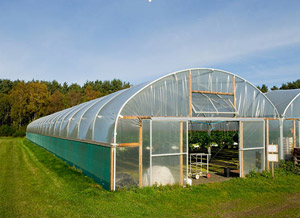Greenhouse
Inside a greenhouse, plants are not exposed to physical wear and tear caused by environmental elements. Issues such as rain, strong winds, hail and high solar radiation often affect the quality of the products. Therefore, the quality of the products obtained inside greenhouses is higher.
They are manufactured in various sizes, giving small farmers and families the possibility of having them instead of open field crops. They usually have a translucent outer cover made of glass or plastic, which allows the control of temperature, humidity and other environmental factors. The greenhouse takes advantage of the effect produced by solar radiation that, when passing through glass or translucent plastic, heats the environment and the objects inside; these, in turn, emit infrared radiation, with a wavelength greater than that of the sun, which produces the heating of the environment.
Under dry conditions where water is scarce, it is important to consider the use of this vital element efficiently, such as drip irrigation. This is why productive strategies must be used that allow us to adequately face the new scenarios that imply less water availability and higher temperatures, allowing the development of horticulture and other types of crops in regions where without greenhouses these products could not be grown, or could not be done for such a long period of the year.
 Advantages of greenhouses over conventional crops
Advantages of greenhouses over conventional crops
- Crop protection.
- Crops have a higher nutritional level.
- They are not dependent on the climate.
- Nutrients are not depleted.
- Continuous irrigation.
- Reuse of water.
- Prevents weeds.
- More efficient use of inputs.
BACK